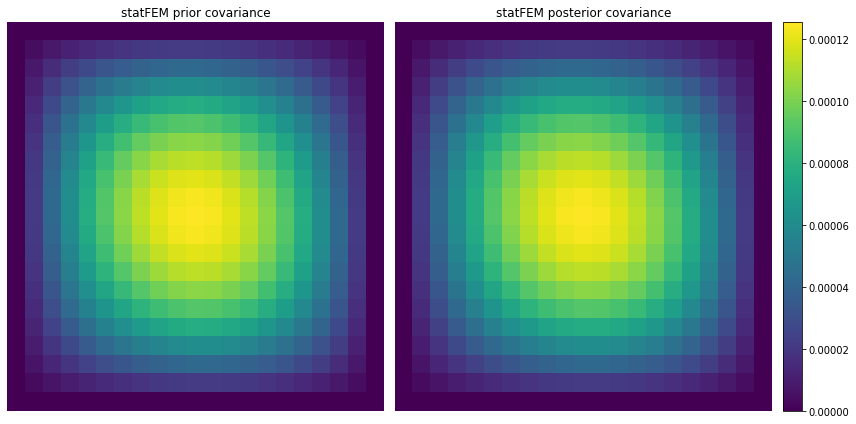Building up tools to analyse a 1-D problem
Code for a 1-D problem.
[1]:
from dolfin import *
import numpy as np
from scipy.interpolate import interp1d
import matplotlib.pyplot as plt
import seaborn as sns
import matplotlib.cm as cm
plt.rcParams['figure.figsize'] = (10,6)
import sympy; sympy.init_printing()
# code for displaying matrices nicely
def display_matrix(m):
display(sympy.Matrix(m))
1 dimensional case (ODE)
We consider the following 1-D problem:
where here \(f\) is a random forcing term, assumed to be a GP in this work.
Variational formulation
The variational formulation is given by:
where:
and
We will make the following choices for \(p,f\):
Difference between true prior mean and statFEM prior mean
Since the mean of \(f\) is \(\bar{f}(x)=1\) we have that the true mean of the solution \(u\) is the solution of the ODE with forcing term set to the constant function 1. This has the exact analytic solution:
as can be directly verified.
The FEM approximation to the solution distribution has mean \(\boldsymbol{\Phi}(x)^{*}A^{-1}\bar{F}\) which is the solution to the approximate variational problem obtained by replacing \(f\) with \(\bar{f}\) in the linear form \(L\).
We will utilise FEniCS to compute the error between these two as a function of \(h\) the mesh size. To do this we first create a function mean_assembler() which will assemble the mean for the statFEM prior.
[2]:
from statFEM_analysis.oneDim import mean_assembler
mean_assembler takes in the mesh size h and the mean function f_bar for the forcing and computes the mean of the approximate statFEM prior, returning this as a FEniCS function.
Important:
mean_assembler requires f_bar to be represented as a FEniCS function/expression/constant.
Let’s check that this is working:
[3]:
h = 0.15
f_bar = Constant(1.0)
μ = mean_assembler(h,f_bar)
μ
[3]:
Coefficient(FunctionSpace(Mesh(VectorElement(FiniteElement('Lagrange', interval, 1), dim=1), 1), FiniteElement('Lagrange', interval, 1)), 9)
[4]:
# check the type of μ
assert type(μ) == function.function.Function
As explained above the true mean is the function \(u(x)=\frac{1}{2}x(1-x)\). Let’s check that the approximate mean resembles this by plotting both:
[5]:
# use FEniCS to plot μ
x = np.linspace(0,1,100)
μ_true = 0.5*x*(1-x)
plt.plot(x,μ_true,label='true mean',color='red')
plot(μ,label='FEM approximation',color='blue')
plt.legend()
plt.xlabel(r'$x$')
plt.grid()
plt.show()
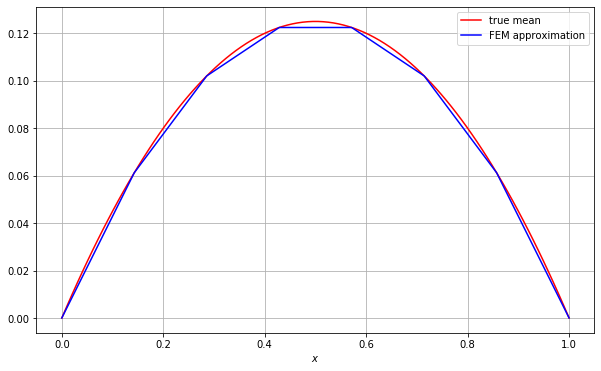
We can see that the FEM approximation does indeed resemble the true mean!
Difference between true prior covariance and statFEM prior covariance
The solution \(u\) has covariance function \(c_u(x,y)\) given by the following expression:
Where \(G(x,y)\) is the Green’s function for our problem:
(note: \(\Theta(x)\) is the Heaviside Step function)
The statFEM covariance can be approximated as follows:
where \(Q=A^{-1}MC_{f}M^{T}A^{-T}\) and where the \(\{\varphi_{i}\}_{i=1}^{J}\) are the FE basis functions corresponding to the interior nodes of our domain. \(C_f\) is the kernel matrix of \(f\) (evaluated on the FEM grid).
The difference between the covariance operators we are interested in computing is the following contribution to the 2-Wasserstein distance between the true solution GP and the approximate FEM GP:
where \(C_1, C_2\) are the covariance operators corresponding to \(c_u\) and \(c_u^{\text{FEM}}\) respectively.
The above quantity will be approximated by fixing a fine grid and computing the cov matrices \(\Sigma_1, \Sigma_2\) for the cov operators \(C_1, C_2\), respectively, on this grid. We will then utilise the approximation:
\(d_W(C_1,C_2)\approx \operatorname{tr} \Sigma_1 +\operatorname{tr} \Sigma_2-2\operatorname{tr}\sqrt{\Sigma_{1}^{1/2}\Sigma_{2}\Sigma_{1}^{1/2}}\)
Thus, it will be necessary to write code to form the matrices \(\Sigma_1,\Sigma_2\) above. The structure of the approximate \(c_u^{\text{FEM}}\) will allow us to compute \(\Sigma_2\) in a very efficient manner using FEniCS. This is achieved by noting that we can write:
where \(\boldsymbol{\phi}(x):=\left(\varphi_1(x),\cdots,\varphi_J(x)\right)^{T}\)
Written in this form, it is now easy to see that \(\Sigma_2\), whose \(ij\)-th entry is given by \((\Sigma_2)_{ij}=\boldsymbol{\phi}(x_i)^{T}Q\boldsymbol{\phi}(x_j)\), can be expressed as follows:
where \(\boldsymbol{\Phi}\) is a \(J\times N\) matrix whose \(i\)th column is given by \(\boldsymbol{\phi}(x_i)\) where \(\{x_i\}_{i=1}^{N}\) are the grid points.
Thus, provided we can efficiently compute the matrices \(\boldsymbol{\Phi}\) and \(Q\) with FEniCS we can efficiently compute the differene between the covariances required.
In order to compute \(\Sigma_1\) and the matrix \(C_f\) needed for \(Q\) we will need to be able to construct a covariance matrix on a grid for a given cov function. We thus will first create a function kernMat() which assembles the covariance matrix corresponding to the covariance function k on a grid grid.
[6]:
from statFEM_analysis.oneDim import kernMat
Note:
This function takes in two optional boolean arguments parallel and translation_inv. The first of these specifies whether or not the cov matrix should be computed in parallel and the second specifies whether or not the cov kernel is translation invariant. If it is, the covariance matrix is computed more efficiently using the cdist function from scipy.
Let’s quickly test if this function is working, by computing the cov matrix for white noise, which has kernel function \(k(x,y)=\delta(x-y)\). For a grid of length \(N\) this should be the \(N\times N\) identity matrix.
[7]:
# set up the kernel function
# set up tolerance for comparison
tol = 1e-16
def k(x,y):
if np.abs(x-y) < tol:
# x == y within the tolerance
return 1.0
else:
# x != y within the tolerance
return 0.0
# set up grid
N = 21
grid = np.linspace(0,1,N)
K = kernMat(k,grid,True,False) # parallel mode
# check that this is the N x N identity matrix
assert (K == np.eye(N)).all()
We now create a function BigPhiMat() to utilise FEniCS to efficiently compute the matrix \(\boldsymbol{\Phi}\) defined above.
[8]:
from statFEM_analysis.oneDim import BigPhiMat
BigPhiMat takes in two arguments: J, which controls the FE mesh size (\(h=1/J\)), and grid which is the grid in the definition of \(\boldsymbol{\Phi}\). BigPhiMat returns \(\boldsymbol{\Phi}\) as a sparse csr_matrix for memory efficiency.
Note:
Since FEniCS works with the FE functions corresponding to all the FE dofs and our matrix \(\Sigma_2\) only uses the FE functions corresponding to non-boundary dofs we need to account for this in the code. See the source code for BigPhiMat to see how this is done.
We now create a function cov_asssembler() which assembles the approximate FEM covariance matrix on the grid.
[9]:
from statFEM_analysis.oneDim import cov_assembler
cov_assembler takes in several arguments which are explained below:
J: controls the FE mesh size (\(h=1/J)\)k_f: the covariance function for the forcing \(f\)grid: the reference grid where the FEM cov matrix should be computed onparallel: boolean argument indicating whether the intermediate computation of \(C_f\) should be done in paralleltranslation_inv: boolean argument indicating whether the intermediate computation of \(C_f\) should be computed assumingk_fis translation invariant or not
As a quick demonstration that the code is working, we will compute the true and approximate covariance matrices for a relatively coarse grid. We first set up functions to compute the true covariance matrix \(\Sigma_1\):
[10]:
# set up kernel functions for f
l_f = 0.4
σ_f = 0.1
def c_f(x,y):
return (σ_f**2)*np.exp(-(x-y)**2/(2*(l_f**2)))
# translation invariant form of c_f
def k_f(x):
return (σ_f**2)*np.exp(-(x**2)/(2*(l_f**2)))
# use quadrature for the true cov function
from scipy import integrate
# compute inner integral over t
def η(w,y):
I_1 = integrate.quad(lambda t: t*c_f(w,t),0.0,y)[0]
I_2 = integrate.quad(lambda t: (1-t)*c_f(w,t),y,1.0)[0]
return (1-y)*I_1 + y*I_2
# use this function η and compute the outer integral over w
def c_u(x,y):
I_1 = integrate.quad(lambda w: (1-w)*η(w,y),x,1.0)[0]
I_2 = integrate.quad(lambda w: w*η(w,y),0.0,x)[0]
return x*I_1 + (1-x)*I_2
With these functions we can now compute \(\Sigma_1\) as follows:
[11]:
# set up a reference grid
N = 21
grid = np.linspace(0,1,N)
# compute Σ_1 using c_u
Σ_1 = kernMat(c_u,grid,True,False)
We now use our function cov_assembler to compute \(\Sigma_2\):
[12]:
J = 20 # choose a FE mesh size
Σ_2 = cov_assembler(J,k_f,grid,False,True)
Let’s plot heatmaps of both \(\Sigma_1, \Sigma_2\) to compare:
[13]:
vmin = min(Σ_1.min(), Σ_2.min())
vmax = max(Σ_1.max(), Σ_2.max())
plt.rcParams['figure.figsize'] = (12,6)
fig, axs = plt.subplots(ncols=3, gridspec_kw=dict(width_ratios=[4,4,0.2]))
sns.heatmap(Σ_1,cbar=False,
annot=False,
xticklabels=False,
yticklabels=False,
cmap=cm.viridis,
ax=axs[0])
axs[0].title.set_text(r'$\Sigma_1$')
sns.heatmap(Σ_2,cbar=False,
annot=False,
xticklabels=False,
yticklabels=False,
cmap=cm.viridis,
ax=axs[1])
axs[1].title.set_text(r'$\Sigma_2$')
fig.colorbar(axs[np.argmax([Σ_1.max(), Σ_2.max()])].collections[0], cax=axs[2])
plt.tight_layout()
plt.show()
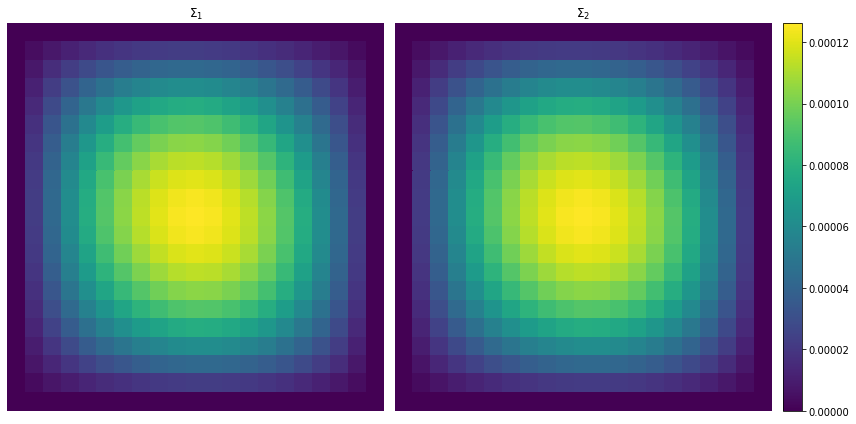
Even with a relatively coarse reference grid and a relatively coarse FE space it looks as if the approximate FEM covariance is quite similar to the true covariance matrix as can be seen from the heatmaps above. Let’s also check how similar they are by utilising np.linalg.norm to compute the relative percentage difference:
[14]:
print("Relative percentage difference is: %.2f" %(100*np.linalg.norm(Σ_1-Σ_2)/np.linalg.norm(Σ_1)) + "%")
Relative percentage difference is: 0.68%
Posterior from incorporating sensor readings
Denote by \(\nu_{i}=\mathcal{N}(m_{i},\Sigma_{i})\), where \(i\) is either the symbol \(\star\) or \(h\), the true and statFEM prior respectively. When we take \(u\sim\nu_{i}\) as our prior, the resulting posterior after incorporating the noisy sensor readings \(\mathbf{v}\) at the locations \(\{y_{j}\}_{j=1}^{s}\) is given by:
where we have:
where \(S\) is the operator which maps a function \(g\) to the vector \(\left(g(y_1),\cdots,g(y_s)\right)^{T}\).
For brevity we will denote the \(s\times s\) matrix which appears above as \(B_{\epsilon,i}:=\epsilon^{2}I+S\Sigma_{i}S^{\dagger}=\epsilon^{2}I+C_{Y,i}\) where we have also defined \(C_{Y,i}:=S\Sigma_{i}S^{\dagger}\). This matrix has \(pq\)-th entry \(c^{(i)}(y_{p},y_{q})\) where \(c^{(i)}\) is the covariance function associated with the covariance operator \(\Sigma_{i}\).
Posterior mean
Thus, our posterior mean in both cases has the form:
Note that this can be expressed as:
where \(\mathbf{m}^{(i)}:=Sm_{i}=(m_{i}(y_1),\cdots,m_{i}(y_s))^{T}\) and \(\mathbf{c}^{(i)}(x):=(c^{(i)}(x,y_1),\cdots,c^{(i)}(x,y_s))^{T}\).
Thus, we require a function to evaluate the posterior means. We will thus create a function m_post() which evaluates the posterior means.
[15]:
from statFEM_analysis.oneDim import m_post
m_post takes in several arguments which are explained below:
x: point where the posterior mean will be evaluatedm: function which computes the prior mean at a given point yc: function which returns the vector (c(x,y)) for y in Y (note: c is the prior covariance function)v: vector of noisy sensor readingsY: vector of sensor locationsB: the matrix \(\epsilon^{2}I+C_Y\) to be inverted in order to obtain the posterior
As a quick test to see if the code is working, note that if we choose \(\mathbf{c}\) above to be constant at the \(j\)-th standard basis vector and if we take \(B\) to be the identity matrix then we should obtain the function \(m(x)-m(y_j)+v_j\). This will give us the \(v_j\) when evaluated at \(y_j\). We will test that this is indeed what we get:
[16]:
# choose several prior mean functions to try
m_list = [lambda x: 1.0, lambda x: 0.5*x*(1.0-x), lambda x: np.sin(2*np.pi*x)]
# set up Y and B and v:
Y = np.linspace(0.01,0.99,11)
s = len(Y)
B = np.eye(s)
np.random.seed(42)
v = np.random.randn(s)
# test that we get v_j when evaluated at y_j (and when c is set to be j-th basis vector)
for j in range(s):
# define c to be j-th basis vector for all x
def c(x):
c_vect = np.zeros(s)
c_vect[j] = 1.0
return c_vect
# evaluate the posterior mean at jth sensor location and check that this is v_j
# (this check is done up to a tolerance tol)
tol = 1e-15
for m in m_list:
assert np.abs(m_post(Y[j],m,c,v,Y,B) - v[j]) < tol
Difference between posterior means
In order to compute the difference between the posterior means we require some more code.
Firstly, we will need code to generate samples from a GP with mean \(m\) and cov function \(k\) on a grid. We write the function sample_gp() for this purpose.
[17]:
from statFEM_analysis.oneDim import sample_gp
sample_gp takes in several arguments which are explained below:
n_sim: number of trajectories to be sampledm: mean function for the GPk: cov function for the GPgrid: grid of points on which to sample the GPpar: boolean argument indicating whether the computation of the cov matrix should be done in paralleltrans: boolean argument indicating whether the computation of the cov matrix should be computed assumingkis translation invariant or nottol: controls the size of the tiny diagonal perturbation added to cov matrix to ensure it is strictly positive definite (defaults to1e-9)
As a quick demonstration that the code is working lets generate 10 trajectories of white noise, using the kernel k from one of the previous tests:
[18]:
# set up grid to sample on
N = 51
grid = np.linspace(0,1,N)
# set up mean
def m(x):
return 0.0
# sample the GP
n_sim = 10
np.random.seed(235)
samples = sample_gp(n_sim,m,k,grid,True,False)
plt.plot(grid,samples)
plt.grid()
plt.xlabel(r'$x$')
plt.title('White noise trajectories')
plt.show()
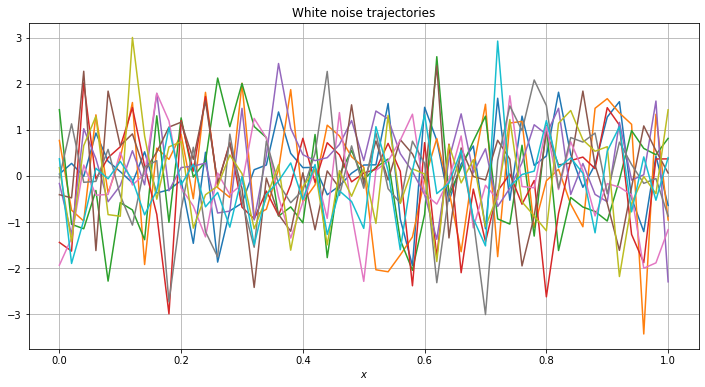
The next bit of code we require is code to generate noisy sensor readings from our system. We write the function gen_sensor() for this purpose.
[19]:
from statFEM_analysis.oneDim import gen_sensor
gen_sensor takes in several arguments which are explained below:
ϵ: controls the amount of sensor noisem: mean function for the forcing fk: cov function for the forcing fY: vector of sensor locationsu_quad: function to accurately compute the solution u given a realisation of the forcing fgrid: grid where forcing f is sampled onpar: boolean argument indicating whether the computation of the forcing cov matrix should be done in paralleltrans: boolean argument indicating whether the computation of the forcing cov matrix should be computed assumingkis translation invariant or nottol: controls the size of the tiny diagonal perturbation added to forcing cov matrix to ensure it is strictly positive definite (defaults to1e-9)maxiter: parameter which controls the accuracy of the quadrature used in u_quad (defaults to50)require_f: boolean argument indicating whether or not to also return the realisation of the forcing f (defaults toFalse)
Important:
The function u_quad which is passed to gen_sensor is assumed to compute the solution using quadrature. This must be done in a particular way and will be demonstrated below. It is also important to choose a fine enough grid for the argument grid passed to gen_sensor as this affects the solution accuracy.
Let’s demonstrate that this code is working. To start we note that due to the form of the Green’s function for our problem, we can express the solution \(u\) in terms of the forcing \(f\) as follows:
We will use this observation when setting up u_quad below. We now generate \(s=20\) sensor observations with the sensors equally spaced in the interval \((0.01,0.99)\).
[20]:
# set up mean and kernel functions for the forcing f
l_f = 0.4
σ_f = 0.1
def m_f(x):
return 1.0
def k_f(x):
return (σ_f**2)*np.exp(-(x**2)/(2*(l_f**2)))
# set up sensor grid and sensor noise level
s = 20
Y = np.linspace(0.01,0.99,s)
ϵ = 0.1
# set up grid to simulate f on
N = 40
grid = np.linspace(0,1,N+1)
# set up u_quad
def u_quad(x,f,maxiter=50):
I_1 = integrate.quadrature(lambda w: w*f(w), 0.0, x,maxiter=maxiter)[0]
I_2 = integrate.quadrature(lambda w: (1-w)*f(w),x, 1.0,maxiter=maxiter)[0]
return (1-x)*I_1 + x*I_2
# generate the sensor observations
np.random.seed(534)
v_dat,f_sim = gen_sensor(ϵ,m_f,k_f,Y,u_quad,grid,maxiter=200,require_f=True)
Plotting these sensor observations with the solution for this particular realisation of the forcing gives:
[21]:
# plot the sensor readings as well as the true mean
x_range = np.linspace(0,1,100)
f = interp1d(grid,f_sim.flatten(),kind='cubic')
def u(x):
return u_quad(x,f,maxiter=200)
res = np.array([u(x) for x in x_range])
plt.scatter(Y,v_dat,c='r',label='noisy sensor observations')
plt.plot(x_range,res,c='b',label='solution')
plt.xlabel(r'$x$')
plt.ylim(-0.2,0.3)
plt.title('Noisy sensor observations')
plt.legend()
plt.grid()
plt.show()
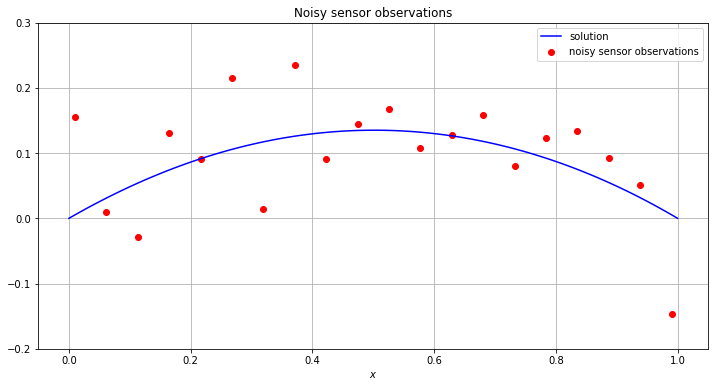
The next bit of code needed in order to compute the difference between the posterior means is a way of comparing the two different mean functions. One possible solution is to overload the UserExpression class in FEniCS to create custom FEniCS expressions from user defined functions. This will allow us to use our function m_post together with errornorm from FEniCS to compute the L2 norm of the difference. We thus, create a class called
MyExpression().
[22]:
from statFEM_analysis.oneDim import MyExpression
We will now demonstrate how this works, building on the sensor observation example above.
[23]:
# set up the true prior mean and the true prior cov needed for the true posterior
μ_true = Expression('0.5*x[0]*(1-x[0])',degree=2)
C_true_s = kernMat(c_u,Y.flatten())
def c_u_vect(x):
return np.array([c_u(x,y_i) for y_i in Y])
# set up matrix B for posterior
B_true = (ϵ**2)*np.eye(s) + C_true_s
# compute the true posterior mean
def true_post_mean(x):
return m_post(x,μ_true,c_u_vect,v_dat,Y,B_true)
# set up MyExpression object
μ_true_post = MyExpression()
μ_true_post.f = true_post_mean
μ_true_post
[23]:
Coefficient(FunctionSpace(None, FiniteElement('Lagrange', None, 2)), 44)
μ_true_post now works like a usual FEniCS expression/function. We can evaluate it at a point:
[24]:
μ_true_post(0.3)
[24]:
Or even evaluate it on the nodes of a FEniCS mesh:
[25]:
μ_true_post.compute_vertex_values(mesh=UnitIntervalMesh(5))
[25]:
array([0. , 0.08179325, 0.12278251, 0.12279555, 0.08181789,
0. ])
Warning:
A mesh needs to be passed when using MyExpression objects with certain FEniCS methods
We now require code which will create the matrix \(C_Y,h\) and the function \(\mathbf{c}^{(h)}\) required for the statFEM posterior mean. We will create the function fem_cov_assembler_post() for this purpose.
[26]:
from statFEM_analysis.oneDim import fem_cov_assembler_post
fem_cov_assembler_post takes in several arguments which are explained below:
J: controls the FE mesh size (\(h=1/J\))k_f: the covariance function for the forcing \(f\)Y: vector of sensor locationsparallel: boolean argument indicating whether the computation of the forcing cov mat should be done in paralleltranslation_inv: boolean argument indicating whether the computation of the forcing cov mat should be computed assumingk_fis translation invariant or not
With all of this code in place we can now finally write the function m_post_fem_assembler() which will assemble the statFEM posterior mean function.
[27]:
from statFEM_analysis.oneDim import m_post_fem_assembler
m_post_fem_assembler takes in several arguments which are explained below:
J: controls the FE mesh size (\(h=1/J\))f_bar: the mean function for the forcing \(f\)k_f: the covariance function for the forcing \(f\)ϵ: controls the amount of sensor noiseY: vector of sensor locationsv_dat: vector of noisy sensor observationspar: boolean argument passed tofem_cov_assembler_post’s argumentparallel(defaults toFalse)trans: boolean argument passed tofem_cov_assembler_post’s argumenttranslation_inv(defaults toTrue)
Important:
m_post_fem_assembler requires f_bar to be represented as a FEniCS function/expression/constant.
Let’s quickly check that this function is working.
[28]:
J = 20
f_bar = Constant(1.0)
m_post_fem = m_post_fem_assembler(J,f_bar,k_f,ϵ,Y,v_dat)
# compute posterior mean at a location x in [0,1]
x = 0.3
m_post_fem(x)
[28]:
Let’s also plot the statFEM posterior mean together with the corresponding statFEM prior mean:
[29]:
h = 1/J
m_prior = mean_assembler(h,f_bar)
x_range = np.linspace(0,1,100)
y_range = np.array([m_post_fem(x) for x in x_range])
plot(m_prior,label='prior')
plt.plot(x_range,y_range,label='posterior',c='r')
plt.grid()
plt.xlabel(r'$x$')
plt.title('statFEM prior and posterior means')
plt.legend()
plt.show()
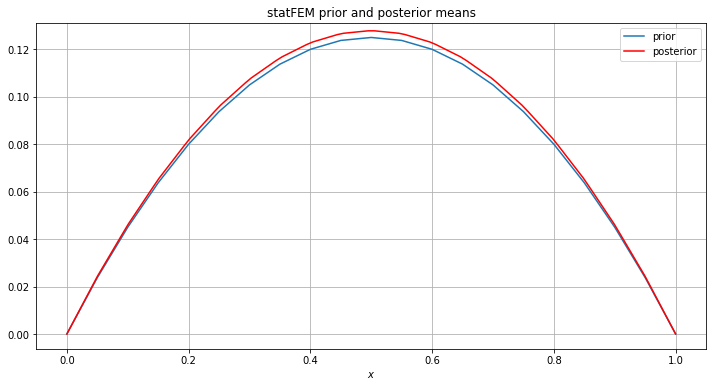
Posterior covariance
From the form of the posterior covariance operators \(\Sigma_{u|\mathbf{v}}^{(i)}\) given in the section “Posterior from incorporating sensor readings” we can see that the posterior covariance functions both have the form:
Note that this can be expressed as:
where we have utilised the fact that \(c^{(i)}\) are covariance functions and are hence symmetric which allows us to put \(\mathbf{c}^{(i)}(y)=(c^{(i)}(y,y_1),\cdots,c^{(i)}(y,y_s))^{T}=(c^{(i)}(y_1,y),\cdots,c^{(i)}(y_s,y))^{T}\).
Thus, we require a function to evalute the posterior covarainces. We will thus create a function c_post() which evalutes the posterior covariances.
[30]:
from statFEM_analysis.oneDim import c_post
c_post takes in several arguments which are explained below:
x,y: points to evaluate the covariance atc: function which returns the prior covariance at any given pair \((x,y)\)Y: vector of sensor locationsB: the matrix \(\epsilon^{2}I+C_{Y}\) to be inverted in order to obtain the posterior
Note:
The function c_post will only be used for the true posterior covariances.
Difference between posterior covariances
In order to compute the difference between the posterior covariances we require some more code. Since we will be comparing the posterior covariances on a fixed reference grid \(\{x_{i}\}_{i=1}^{N}\) we will need to assemble the cov matrices on this grid. I.e. we will require the matrices \(\tilde{C}_{X,i}\) with \(pq\)-th entry \(c_{u|\mathbf{v}}^{(i)}(x_{p},x_{q})\) for \(p,q=1,\cdots N\). For statFEM this matrix can be efficiently assembled by exploiting the form of the statFEM prior and posterior covariance functions, i.e. by noting that we have:
where \(\Sigma_{X}:=\Phi_{X}^{T}Q\Phi_{X}\), \(\Sigma_{XY}=\Phi_{X}^{T}Q\Phi_{Y}\) and where \(\Phi_{X}\) is a \(J\times N\) matrix whose \(i\)-th column is given by \(\phi(x_{i})\) and similarly \(\Phi_{Y}\) is a \(J\times s\) matrix whose \(i\)-th column is given by \(\phi(y_{i})\) and \(Q\) is the matrix defined in the section “Difference between the true prior covariance and the statFEM prior covariance”.
Thus, we can use our function BigPhiMat to compute \(\tilde{C}_{X,h}\) efficiently. We start by creating the function post_fem_cov_assembler() which assembles the matrices \(\Sigma_{X}, \Sigma_{XY}\), and \(\Sigma_{Y}:=\Phi_{Y}^{T}Q\Phi_{Y}\) required for the statFEM posterior covariance.
[31]:
from statFEM_analysis.oneDim import post_fem_cov_assembler
post_fem_cov_assembler takes in several arguments which are explained below:
J: controls the FE mesh size (\(h=1/J\))k_f: the covariance function for the forcing \(f\)grid: the fixed reference grid \(\{x_{i}\}_{i=1}^{N}\) on which to assemble the posterior cov matY: vector of sensor locations.parallel: boolean argument indicating whether the computation of the forcing cov mat should be done in paralleltranslation_inv: boolean argument indicating whether the computation of the forcing cov mat should be computed assumingk_fis translation invariant or not
Finally, we create the function c_post_fem_assembler() which assembles the statFEM posterior cov mat on the reference grid using the matrices post_fem_cov_assembler returns.
[32]:
from statFEM_analysis.oneDim import c_post_fem_assembler
Let’s quickly demonstrate that this code is working by computing the statFEM posterior covariance matrix on a reference grid and comparing this to the corresponding statFEM prior.
[33]:
# set up reference grid and J
N = 21
grid = np.linspace(0,1,N)
J = 20
# get statFEM prior cov mat on this grid
Σ_prior = cov_assembler(J,k_f,grid,False,True)
# get statFEM posterior cov mat on this grid
Σ_posterior = c_post_fem_assembler(J,k_f,grid,Y,ϵ,False,True)
[34]:
vmin = min(Σ_prior.min(), Σ_posterior.min())
vmax = max(Σ_prior.max(), Σ_posterior.max())
plt.rcParams['figure.figsize'] = (12,6)
fig, axs = plt.subplots(ncols=3, gridspec_kw=dict(width_ratios=[4,4,0.2]))
sns.heatmap(Σ_prior,cbar=False,
annot=False,
xticklabels=False,
yticklabels=False,
cmap=cm.viridis,
ax=axs[0])
axs[0].title.set_text('statFEM prior covariance')
sns.heatmap(Σ_posterior,cbar=False,
annot=False,
xticklabels=False,
yticklabels=False,
cmap=cm.viridis,
ax=axs[1])
axs[1].title.set_text('statFEM posterior covariance')
fig.colorbar(axs[np.argmax([Σ_prior.max(), Σ_posterior.max()])].collections[0], cax=axs[2])
plt.tight_layout()
plt.show()
